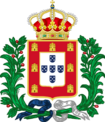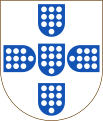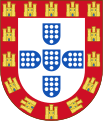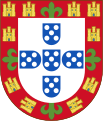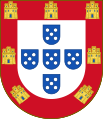Kingdom of Portugal facts for kids
Quick facts for kids
Kingdom of Portugal
|
|||||||||||||
|---|---|---|---|---|---|---|---|---|---|---|---|---|---|
| 1139–1910 | |||||||||||||
|
|
|||||||||||||
|
Anthem: "Hymno Patriótico" (1809–1834)
"Patriotic Anthem" Hino da Carta (1834–1910) "Anthem of the Charter" |
|||||||||||||
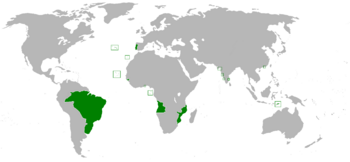
The Kingdom of Portugal in 1800
|
|||||||||||||
| Capital | Coimbra (1139–1255) Lisbon[a] (1255–1808) Angra do Heroísmo[b] (1580–1582) Rio de Janeiro (1808–1821) Lisbon (1821–1910) Angra do Heroísmo[c] (1830–1834) |
||||||||||||
| Common languages | Official languages:
Unofficial languages:
|
||||||||||||
| Religion | Majority: Roman Catholicism (official) Minority: Sephardic Judaism Islam |
||||||||||||
| Demonym(s) | Portuguese | ||||||||||||
| Government | Feudal constitutional monarchy (1139–1698) Absolute monarchy (1698–1820; 1823–1826; 1828–1834) Unitary parliamentary semi-constitutional monarchy (1822–1823; 1826–1828; 1834-1910) |
||||||||||||
| Monarch | |||||||||||||
|
• 1139–1185 (first)
|
Afonso I | ||||||||||||
|
• 1908–1910 (last)
|
Manuel II | ||||||||||||
| Prime Minister | |||||||||||||
|
• 1834–1835 (first)
|
Marquis of Palmela | ||||||||||||
|
• 1910 (last)
|
Teixeira de Sousa | ||||||||||||
| Legislature | Cortes (1139-1706; 1816-1820) None (rule by decree) (1698–1820; 1823–1826; 1828–1834) The General and Extraordinary Cortes of the Portuguese Nation (1820-1822) Cortes Gerais (1820-1823; 1826-1828; 1834-1910) |
||||||||||||
|
• Upper house
|
Chamber of Peers (1822-1838; 1842-1910) Chamber of Senators (1838-1842) |
||||||||||||
|
• Lower house
|
Chamber of Deputies (1822-1910) |
||||||||||||
| History | |||||||||||||
| 25 July 1139 | |||||||||||||
| 1 December 1640 | |||||||||||||
|
• Lisbon Regicide
|
1 February 1908 | ||||||||||||
|
• Revolution of 1910
|
5 October 1910 | ||||||||||||
| Area | |||||||||||||
| 1300 | 90,000 km2 (35,000 sq mi) | ||||||||||||
| Population | |||||||||||||
|
• 1300
|
800,000 | ||||||||||||
| Currency | Portuguese dinheiro, (1139–1433) Portuguese real (1433–1910) |
||||||||||||
| ISO 3166 code | PT | ||||||||||||
|
|||||||||||||
|
a. ^ The capital was de facto located at Rio de Janeiro from 1808 to 1821.
b. ^ The seat of government of the Portuguese pretender António was de facto located at Angra do Heroísmo from 1580 to 1582. c. ^ The capital of the constitutional government in exile was de jure located at Angra do Heroísmo during the Portuguese Civil War, from 1830 to 1834. |
|||||||||||||
The Kingdom of Portugal was a country in the western part of the Iberian Peninsula. It was ruled by a king or queen and existed from 1139 to 1910. This kingdom was the country that came before the modern Republic of Portugal.
Sometimes, the Kingdom of Portugal was known by longer names. After 1415, it was called the Kingdom of Portugal and the Algarves. Between 1815 and 1822, it was known as the United Kingdom of Portugal, Brazil and the Algarves. The term "Kingdom of Portugal" is also often used to describe the large empire it built overseas.
The start of Portugal as a country began with the County of Portugal. This area was formed in the 9th century during the Reconquista, which was a long period when Christian kingdoms took back land from Muslim rule. A leader named Vímara Peres helped create this county. Later, the county became part of the Kingdom of León. But in the 12th century, after the battle of São Mamede, the leaders of Portugal became kings of their own independent kingdom.
Portugal was first ruled by the Alfonsine Dynasty. This changed after a big crisis between 1383 and 1385. After that, the House of Aviz took over the throne.
During the 15th and 16th centuries, Portugal became famous for its explorers. These explorers built a huge colonial empire all over the world. From 1580 to 1640, the Kingdom of Portugal was joined with Habsburg Spain under the same king. This was called the Iberian Union.
After the Portuguese Restoration War (1640–1668), Portugal became independent from Spain again. The House of Braganza then ruled, followed by the House of Braganza-Saxe-Coburg and Gotha. Portugal's power slowly decreased, but it remained important because of its valuable colony, Brazil.
After Brazil became independent, Portugal tried to expand its influence in Africa. However, the British Ultimatum of 1890 stopped this expansion. This event, along with other issues, led to the end of the monarchy. The 5 October 1910 revolution overthrew the king and created the First Portuguese Republic.
Before 1822, Portugal was an absolute monarchy. This meant the king had all the power. From 1822 to 1834, it switched between being an absolute monarchy and a constitutional monarchy. In a constitutional monarchy, the king's power is limited by a constitution or laws. After 1834, Portugal remained a constitutional monarchy until the monarchy ended.
Contents
History of the Kingdom
How Portugal Became a Kingdom
The Kingdom of Portugal started from the County of Portugal. This county was a semi-independent area within the Kingdom of León. Portugal gained its independence in three main steps:
- Step 1: On July 26, 1139, Afonso Henriques was declared the first King of the Portuguese.
- Step 2: On October 5, 1143, Alfonso VII of León and Castile, the King of León, officially recognized Afonso Henriques as king. This happened through the Treaty of Zamora.
- Step 3: In 1179, Pope Alexander III recognized Portugal's independence. This was done through an important document called the Papal Bull Manifestis Probatum.
After Portugal became independent, King Afonso I's family, the Portuguese House of Burgundy, ruled until 1383. Even when new royal families took over, all future kings and queens of Portugal were related to Afonso I in some way.
Portugal's Golden Age: Exploration and Empire
During the 15th and 16th centuries, Portugal became a global power. This was a time of great exploration. Portuguese sailors and explorers traveled to distant lands, discovering new sea routes and territories.
They built a vast colonial empire that stretched across the globe. This empire brought great wealth and influence to Portugal.
Challenges and Changes
From 1580 to 1640, Portugal faced a big change. It entered a "personal union" with Habsburg Spain. This meant that the King of Spain also became the King of Portugal. Portugal kept its own laws and government, but it shared a ruler with Spain.
In 1640, Portugal fought the Portuguese Restoration War to regain its full independence. After winning this war in 1668, the House of Braganza became the new ruling family.
Over time, Portugal's influence in the world began to decline. However, its most valuable colony, Brazil, helped Portugal remain an important country.
The End of the Monarchy
As the 20th century began, more and more people in Portugal wanted to end the monarchy and create a republic. This idea, called Republicanism, grew stronger, especially in the capital city of Lisbon.
A major event that sped up this change was the Lisbon Regicide on February 1, 1908. On this day, King Charles and his oldest son, Prince Luís Filipe, were assassinated in Lisbon.
King Charles's second son, Manuel II, became the new king. However, his rule was very short. On October 5, 1910, a revolution forced King Manuel II to leave the country. He went into exile in the United Kingdom. This event marked the end of the Kingdom of Portugal and the start of the Portuguese First Republic.
A small attempt to bring back the monarchy happened in 1919 in a city called Oporto. This was known as the Monarchy of the North. But it only lasted for about a month. Since then, there have been no other attempts to restore the monarchy in Portugal.
After the revolution, Portugal's remaining colonies became overseas provinces of the new republic. The last of these territories were handed over in the late 20th century. For example, Angola and Mozambique in Africa became independent in 1975. Macau in Asia was returned to China in 1999.
Rulers of Portugal
Throughout its history, the Kingdom of Portugal was ruled by a series of kings and queens. These monarchs came from different royal families, or "Houses," over the centuries. Each ruling family played a key role in shaping Portugal's history.
Gallery
Flags of the Kingdom
Coats of Arms
Royal Shields
See also
 In Spanish: Reino de Portugal para niños
In Spanish: Reino de Portugal para niños
- Kingdom of Algarve
- United Kingdom of Portugal, Brazil and the Algarves
- List of titles and honours of the Portuguese Crown
- Portuguese nobility
- Portuguese heraldry



